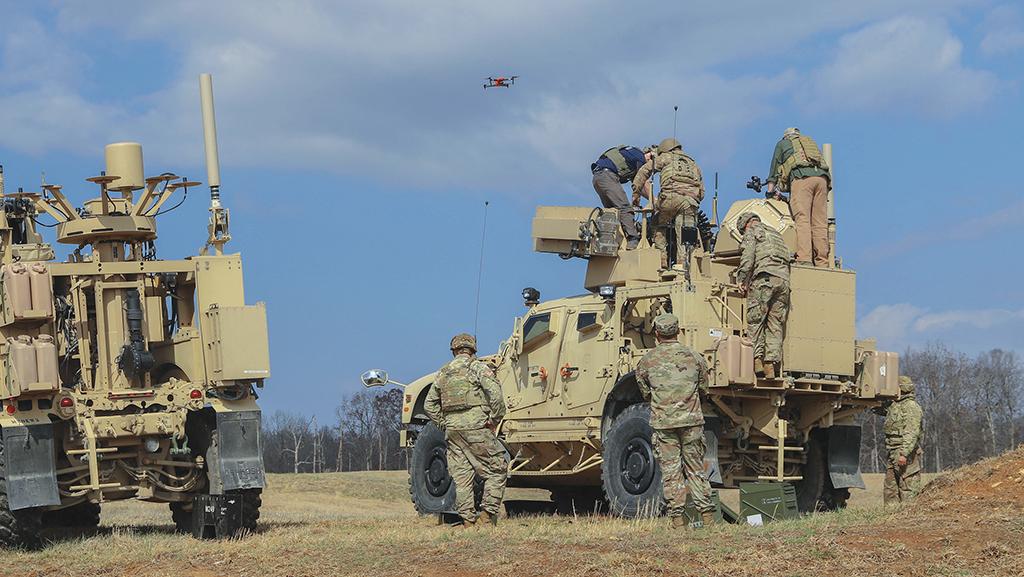
The Army plans to fund more high-power microwave and directed-energy systems.
The U.S. Army’s top official tasked with downing enemy drones has had a funding problem, but a window of opportunity opened this year.
Maj. Gen. Sean Gainey, the only director for the Joint Counter-Small Unmanned Aircraft Systems Office (JCO) since it was stood up in 2020, met with Deputy Defense Secretary Kathleen Hicks in the Pentagon as the Defense Department was putting its budget together. The JCO at the time only had a yearly budget of about $20 million for research into and development of new ways to counter uncrewed aircraft systems (UAS) as Gainey pressed the office to focus on larger drones and—more important—a growing threat of swarming drones.
- The Counter-UAS Office expects R&D budget to rise
- Five companies recommended to provide the mission
“We laid out to the deputy secretary: ‘Ma’am, if we continue on the route of the systems that we’re looking at today . . . it will be very difficult to move forward in the future with the way the threat is scaling and spiraling capability,’” Gainey told a crowd at the Space and Missile Defense Symposium in Huntsville, Alabama, on Aug. 8.
The result is a fivefold increase in the office’s R&D in the current fiscal 2024 budget request, funding that Gainey said will focus largely on directed-energy (DE) development to pursue that top priority of countering UAS at a mass scale. The office plans a large demonstration in 2024 to focus on swarming, as the JCO and its parent—the Army Rapid Capabilities and Critical Technologies Office (RCCTO)—buy more DE and high-power microwave (HPM) systems.
“We are doing directed energy because we don’t have the magazine depth and quite frankly can’t afford the magazine depth to have missiles everywhere that you want them,” Lt. Gen. Robert Rasch, RCCTO director, said Aug. 9 at the event. “So having the capability of directed energy to provide that kind of renewable kill power on a platform is very appealing, but it’s got to be affordable, and it’s got to be reliable.”
The Army’s HPM and DE efforts scale from 10 kW to 300 kW, with prototypes already deployed globally and more to come soon. For example, in the Middle East, the RTX vehicle-mounted Coyote system has deployed with an HPM warhead and has been effective in downing UAS, including Iranian-made Shahed drones. In Africa, the Middle East and the Pacific, 10-kW, high-energy lasers have been deployed, with a new 20-kW platform expected in the Middle East soon.
Large RCCTO-funded systems to come include the 50-kW-class Directed-Energy Maneuver Short-Range Air Defense system that targets small UAS, rotary-wing aircraft, rockets, artillery and mortars. Two of the RTX systems have been delivered after delays to the overall program, with two more expected in the next few months before a potential program of record, Rasch said.
The Army awarded a contract in July to Lockheed Martin and Dynetics for the Indirect Fire Protection Capability (IFPC) High-Energy Laser, a 300-kW-class laser for the same targets as the previous system plus fixed-wing aircraft and cruise missiles. This program’s schedule calls for the prototypes to be delivered in 23 months, he said.
In December, the Army awarded Epirus a contract for four Leonidas systems as part of the IFPC-HPM program to counter UAS swarms. The first delivery took place in July, and the system is now going through government acceptance testing, with the following three expected over the next six months.
Epirus developed the system using venture capital funding and matured it through multiple demonstrations ahead of the contract that started in December 2021, says Aaron Barruga, the company’s vice president for federal growth. Epirus is required to deliver the systems by the fourth quarter of fiscal 2024 but expects the process to be significantly faster, he says.
Smaller, maneuver-focused efforts include the Army Multi-Purpose High-Energy Laser, a 20-kW system from BlueHalo that is set to begin critical design review and delivery of four systems.
The Army and U.S. Special Operations Command are collaborating on the Family of Counter Unmanned Systems, a group of six passive sensors with weapons. Additionally, RCCTO has deployed three RTX 10-kW and 20-kW palletized high-energy lasers with new equipment and upgrades ahead of live-fire exercises.
Gainey said the Defense Department needs a new approach for the mission abroad, buying counter-UAS as a service (CaaS) as opposed to simply buying systems for the military to operate.
“Although it’s great to have capability, procure it and get it out there, what if we pay industry?” Gainey says. “[We] want you to defend this site, you deploy equipment, upgrade it, spiral it and you charge us the cost to do that.”
In late 2022, the JCO recommended five companies to provide this service after a series of demonstrations: Anduril Industries, Black Sage, CACI, Rafael Systems Global Sustainment and SAIC. So far, the U.S. Marine Corps has already funded CaaS at six locations. U.S. Central Command has bought it as well, although specific companies have not been identified. The Army plans to deploy CaaS at two locations, but the service has to deploy uniformed operators as well because current legislation blocks the Army from having the mission fully operated by a contractor.
Deploying more CaaS with a mix of DE and direct attack systems together is necessary as the threat of swarm drones continues to rise, Gainey said.
“The small UAS threat is real, and it’s evolving,” he said. “It’s just going to get more and more challenging.”





